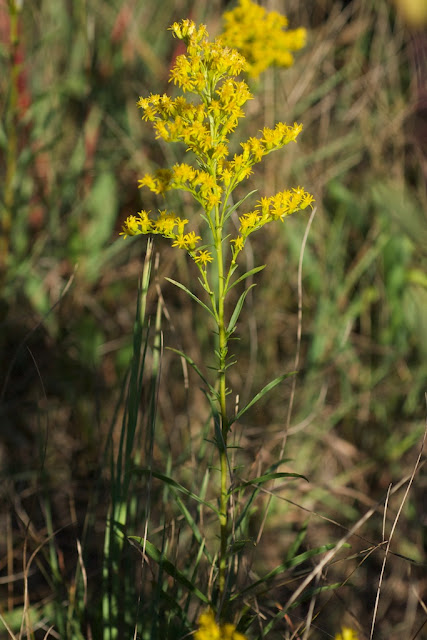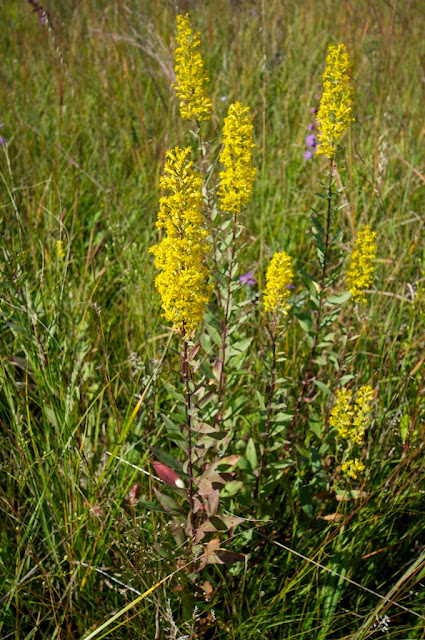Part 1: Goldenrods of Full-Sun sites, Prairies, Fields and Roadsides
Goldenrods are blooming all around us now in late-August and September, some will bloom all the way into October. There are 25 species of goldenrod (In the genera Solidago and Euthamia) in Wisconsin and telling them all apart can be confusing. I'm writing this to help educate our staff, but I thought I'd share with everyone. I have to say, I learned a few things myself as I worked to clear things up here. I'll be covering 18 of the most common and notable species of goldenrod, not every goldenrod in the Midwest, but the most common species.Throughout this guide I'll be underlining key identification information that I use to tell one species from the other, so if you're skimming for identification guidance, look for that.
Part 1 of this guide is for sunny areas, both disturbed sites and prairie remnants. If you are at a site with some shade, check out Part 2 for woodland and savanna goldenrods.
Common, Weedy and Confusing Goldenrods:
Canada goldenrod (Solidago canadensis)
This is, by far, our most common goldenrod species and really, one of the most common plant species overall in the Midwestern landscape. This is a native species that does well in disturbed environments. Roadsides, abandoned fields, even urban areas, are common habitats, but it can also be found abundantly in planted prairies and degraded remnants. It can spread by seed and by rhizomes, and is able to form massive colonies, that can actually really retard prairie restoration efforts.Usually, these form a large monoculture of yellow flowers in early-fall. They can grow to 3-6’. The leaves are alternate and stay about the same size from the bottom to the top, become only slightly smaller towards the apex of the plant. The margins of the leaves are toothed or smooth with a lanceolate to broadly linear shape to them. White hairs can be found on the stems and the underside of the leaves are pubescent and slightly rough to the touch. Relatively small flowers are arranged on the flower stalks, also called the "rachis", which arches out gently and which are generally horizontal. Notably, the stems are rough "scabrous", with short, stiff hairs. This is key differentiator between Canada goldenrod and giant goldenrod.
C = 1
tall goldenrod (Solidago altissima)
Also known as late goldenrod, this species is very difficult to tell apart from Canada goldenrod. Some would say they are subspecies or varieties of the same. Most of my favorite reference books and the Online Flora of Wisconsin separate them out into different species, but interestingly Black and Judziewicz’s Wildflowers of Wisconsin make no mention of tall goldenrod at all. The following descriptive notes reference Wilhelm and Rericha’s Flora of the Chicago Region and John Hilty’s Illinois Wildflowers: (who in-turn references Vascular Flora of Illinois by Robert Mohlenbrock, 2002):Tall goldenrod blooms later than Canada goldenrod. In tall goldenrod, the phyllaries (the overlapping whorl of bracts which subtend each composite flower, also called involucres) are always more than 3mm long, and they are shorter than 3mm in Canada goldenrod.
To me, that's a pretty minor nuance to use to split out a separate species among plants that, ecologically and morphologically, are very similar. However, the apparent differences in flowering times suggest we are looking at populations that cannot interbreed. I think its OK for anyone short of the professional botanist to lump these two species together under the 'Canada goldenrod' banner. It certainly makes no difference for land management purposes.
C = 1
giant goldenrod (Solidago gigantea)
This species is also very similar to Canada goldenrod, and is generally found in similar habitats. From an ecological perspective giant goldenrod tends towards wetter areas. It is weedy and forms colonies, but it is not as weedy as Canada goldenrod. Physically, the easiest way to tell them apart is by the stems. Giant goldenrod has smooth, "glabrous" stems which are often reddish, and which also often have a translucent white, waxy "glaucus" coating that you can wipe off with your fingers. There are some minor differences between giant and Canada goldenrod in the flower arrangement and size as well as the leaf shape and how the leaves attach to the stem. However, there is enough subtlety and variability in these features that they aren't particularly useful for quick field identification. Just remember: giant goldenrod has smooth stems, and Canada goldenrod has rough stems.C = 3
Prairie Goldenrods, Mesic to Dry Sites:
early goldenrod (Solidago juncea)
If you see a goldenrod blooming in July, this is it. The flower period can extend into mid-August in Wisconsin, but early goldenrod is generally finished blooming before the similar Missouri and old-field goldenrods start to bloom. This species has smooth stems and leaves and its leaves get sequentially smaller from the bottom of the plant to the top. Its inflorescences all tend to arch out charmingly to the side. Its a really attractive, short-stature plant, and with its usual bloom time, its a shame its not more readily available for use in landscaping.
C = 4
Missouri goldenrod (Solidago missouriensis)
I'll admit, this is a species that has always confused me. Its a lot like early goldenrod. It blooms earlier than most goldenrods, but not as early as early goldenrod. Its stem and leaves are generally smooth like giant goldenrod and early goldenrod. Its inflorescences all arch outward gracefully. The best way, that I can tell, to differentiate it from early goldenrod is that Missouri goldenrod typically has serrated leaf edges, where as early goldenrod usually has smooth leaf edges. Compared to giant goldenrod, its much shorter, and giant goldenrod is among the last goldenrods to bloom. This species could easily be placed among the "confusing" goldenrods listed above, but I don't think its common enough to make that list. This species is typically found in prairie remnants whether in good condition, or degraded.C = 7
old-field goldenrod (Solidago nemoralis)
Old field goldenrod looks a lot like early goldenrod with its short stature, large basal leaves, and small leaves towards to tops. They often grow in similar habitats too, from dry-mesic to dry prairies and I've seen them in a few savannas and barrens... However, old-field goldenrod, ironically, never grows in old fields. It does seem to stick around in degraded prairies longer than many species, so perhaps it should be called "old-prairie goldenrod"? Its other common name, grey goldenrod, may be more appropriate, because it has a sort-of frosted, grey appearance to the foliage. Its rough to the touch, and blooms in the typical goldenrod season of late-August to early-September, so despite having the same gestalt as early goldenrod, they are easy to tell apart. Its inflorescences generally arch off charmingly to one side. This is another shorter, more charming species that should be used in landscaping more.
C = 4
showy goldenrod (Solidago speciosa)
This species is fairly common in wet-mesic to dry-mesic prairies, and is often found in prairie plantings and wildflower gardens. Its attractive and easy to propagate, but it gets too tall and floppy in relatively rich garden soil. Showy goldenrod is a fairly smooth plant. Its leaves are somewhat smaller as they ascend the stem, and especially small just below the flower plume. Stems are often, but not always, reddish-maroon. The inflorescence (flower plume) is more upright that most goldenrods, (individual flower heads are larger than most), kind of like a big plume of feathers.C = 5
stiff goldenrod (Solidago rigida)
Stiff goldenrod is pretty unique looking among goldenrods Its fairly tall, but very, well, stiff looking, with a thick, rough stem. Leaves are rounded at the tip and have a rough texture. It has relatively large flower heads, that arrange themselves in relatively a flat-topped structure. Some botanists are now assigning this species to a new genus, as Oligoneuron rigidum. With its rather distinctive appearance, this seems justified to me.This species looks tidy in a prairie remnant, but its another one that becomes an oversized ogre in gardens. It is common in planted prairie reconstructions where it can compete well with other tall grasses and forbs.
C = 5
White Goldenrods...?
upland white goldenrod (Solidago ptarmicoides)
It seems a contradiction in terms, but there are in-fact a few white-flowered goldenrods. As the story goes, upland white goldenrod was considered an aster once upon a time (called "stiff aster"), until one botanist noticed that they would hybridize with rough goldenrod. Solidago it is then, white flower or not!This species blooms in late summer or early fall in rocky soils, often on dry sites. Each plant has a handful of white flowers, which are relatively large among the goldenrods, clearly separated from each other, with all the flowers at more or less the same height. These flowers are all at about the same height at the very top of the plant.
Note that some botanists are now splitting this species into a new genus as Oligoneuron album. Its not reverse discrimination because its white, several other yellow-flowering goldenrods are being put into this genus as well (see above).
C = 8
There are two other "white goldenrods" in our area, silver-rod (Solidago bicolor) C = 7, and white goldenrod (Solidago hispida), C = 6. However, these are considerably less common. They also have white flowers that are most-likely to be confused with asters, and both have vertical stalks of flowers, rather than the flat-top of upland white goldenrod.
Interesting side-note: these species are staying in the Solidago genus (rather than being moved to Oligoneuron), as far as I can tell, so it appears that yellow flowers are not necessarily a defining trait of the goldenrods.
An Invasive Goldenrod...?
seaside goldenrod (Solidago sempervirens)This species is from the East Coast and has been moving inland along the interstate highway system. All the excess salt spread on our roadways is creating an environment in which this species has a competitive advantage over other vegetation. Is it truly invasive? I'd call it opportunistic.
The easiest way to identify this species is to note that its always along roadways. It also blooms later than any native goldenrod, in fact it often doesn't start blooming until other goldenrods have finished. We're talking late-October and November here. Leaves and stems are smooth to the touch. Overall appearance is similar to giant goldenrod or an oversized Missouri goldenrod. Leaf shape is distinctively elongated with toothless margins.
C = n/a





































